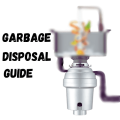Garbage disposals are essential in modern kitchens. They help dispose of food waste efficiently. Understanding their parts is important. This guide covers all you need to know about garbage disposal parts.

Credit: www.plumbingsupply.com
Key Components of a Garbage Disposal
Let’s explore the key parts that make up a garbage disposal unit. Each part plays a crucial role in its operation.
1. Motor
The motor is the heart of the garbage disposal. It powers the grinding mechanism. Most disposals use electric motors. These motors vary in horsepower. Common sizes range from 1/3 to 1 horsepower.
2. Grinding Chamber
The grinding chamber is where food waste is processed. It contains a rotating disc and impellers. The disc and impellers grind the waste into tiny particles.
3. Impellers
Impellers are small, metal components. They are attached to the rotating disc. They help break down food waste. Impellers push waste against the grinding ring.
4. Grinding Ring
The grinding ring is a stationary part. It surrounds the rotating disc. It has sharp edges that help grind food waste. The grinding ring works with the impellers to break down waste.
5. Flywheel
The flywheel is connected to the motor. It helps the grinding mechanism turn smoothly. The flywheel provides momentum for efficient grinding.
6. Sink Flange
The sink flange connects the disposal to the sink drain. It creates a seal to prevent leaks. The sink flange supports the weight of the disposal unit.
7. Splash Guard
The splash guard is a rubber or plastic component. It sits at the top of the disposal unit. It prevents water and waste from splashing out.
8. Discharge Tube
The discharge tube connects the disposal to the plumbing system. It carries ground waste and water to the drain. The discharge tube is usually made of plastic or metal.
9. Reset Button
The reset button is a safety feature. It is located at the bottom of the disposal unit. It trips if the motor overheats or jams. Pressing the reset button restores power to the unit.
10. Power Cord
The power cord supplies electricity to the motor. Some disposals come with a pre-installed power cord. Others require you to install one separately.
Common Problems and Solutions
Garbage disposals can encounter issues. Knowing how to address these problems can save you time and money.
1. Disposal Won’t Turn On
Check the power source. Ensure the unit is plugged in. Press the reset button. If it still doesn’t work, check the circuit breaker.
2. Disposal Hums But Doesn’t Grind
This usually means the flywheel is jammed. Turn off the disposal. Use a hex wrench to turn the flywheel manually. This should dislodge any obstructions.
3. Slow Drainage
Slow drainage can be caused by a clogged discharge tube. Disconnect the tube and clean it. Use a plunger to clear any blockages in the drain.
4. Leaks
Leaks can occur at various points. Check the sink flange, discharge tube, and unit itself. Tighten any loose connections. Replace damaged seals or gaskets.
Maintenance Tips
Regular maintenance can extend the life of your garbage disposal. Follow these tips to keep your unit in good working order.
1. Run Cold Water
Always use cold water when running the disposal. Cold water solidifies grease, making it easier to grind.
2. Avoid Hard Objects
Do not put hard objects in the disposal. Bones, fruit pits, and metal items can damage the grinding mechanism.
3. Clean Regularly
Clean the disposal monthly. Use a mixture of baking soda and vinegar. Let it sit for a few minutes, then rinse with cold water.
4. Use Citrus Peels
Grind citrus peels to freshen your disposal. The natural oils help clean and deodorize the unit.
5. Avoid Chemical Cleaners
Do not use chemical cleaners in your disposal. They can damage the unit and harm the environment.

Credit: www.supplyworks.com
Frequently Asked Questions
What Are Common Garbage Disposal Parts?
Common parts include blades, motors, flanges, and splash guards. These are essential for proper functioning and maintenance.
How To Replace Garbage Disposal Blades?
Turn off power, remove the disposal unit, and replace blades using the manufacturer’s instructions. Reassemble and test.
Where To Buy Garbage Disposal Parts?
Purchase parts from home improvement stores, online retailers, or directly from the manufacturer for the best fit and warranty.
Why Is My Garbage Disposal Leaking?
Leaks often occur due to loose connections, worn gaskets, or cracks in the disposal unit. Inspect and replace faulty parts.
Conclusion
Understanding garbage disposal parts is important. It helps you maintain and troubleshoot your unit. Regular maintenance ensures efficient operation. Follow these tips for a long-lasting disposal. A well-maintained disposal keeps your kitchen clean and functional.
We hope this guide helps you understand your garbage disposal better. Happy grinding!

